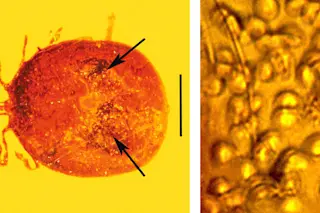An amber-trapped tick found in the Dominican Republic contains the oldest mammalian red blood cells ever discovered. According to a study in the Journal of Medical Entomology in March, a grooming primate likely punctured the tick’s shell — releasing blood and betraying its presence to scientists millions of years later — and then flicked the critter into tree sap, where it was preserved for some 15 million to 45 million years. The cells contain a parasite related to a modern species commonly carried by ticks, shedding light on the entwined history of our ancestors and the organisms that preyed on them.
Amber Preserves Tick’s Last Supper
It's the oldest mammalian red blood cells ever found.

Newsletter
Sign up for our email newsletter for the latest science news
More on Discover
Stay Curious
SubscribeTo The Magazine
Save up to 40% off the cover price when you subscribe to Discover magazine.
Subscribe













